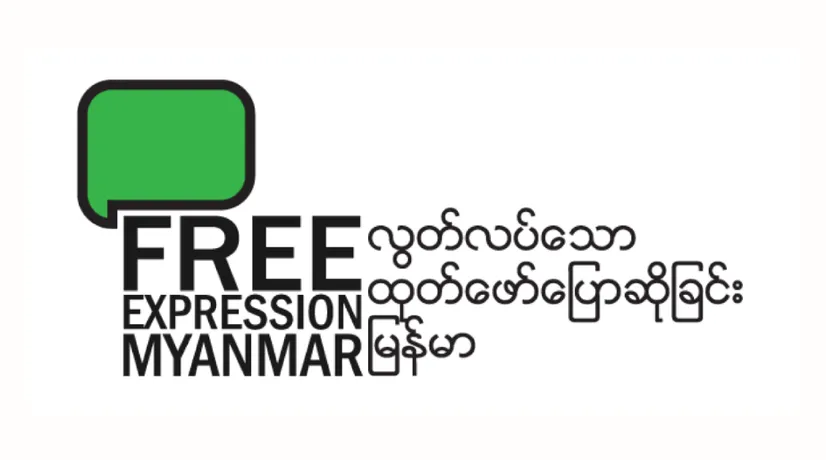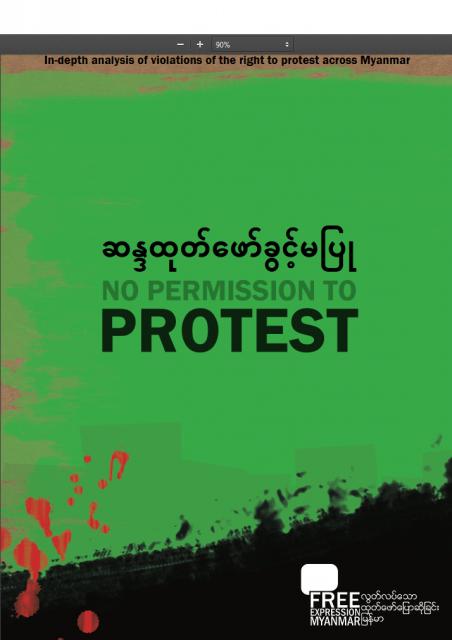No Permission to Protest – ဆန္ဒထုတ်ဖော်ခွင့်မပြု
26 March 2020

 ၂၀၂၀ ပြည့်နှစ်သည် ခေတ်သစ်မြန်မာ့သမိုင်းအတွက် ပထမဦးဆုံးသော အရေးကြီးသည့် ဆန္ဒထုတ်ဖော်မှုများ၏ နှစ် ၁၀၀ ပြည့်အထိမ်းအမှတ် နှစ်တစ်နှစ် ဖြစ်ပါသည်။ နိုင်ငံရေး ခေါင်းဆောင်များ၊ နိုင်ငံရေးပါတီများ၊ ဖွဲ့စည်းပုံအခြေခံဥပဒေအသစ်များနှင့် ရွေးကောက်ပွဲများကို ဆန္ဒထုတ်ဖော်ပွဲများက မိတ်ဆက်ပေးလိုက်ခြင်း ဖြစ်သည်။ ရလဒ်အနေဖြင့် အစိုးရများသည် သမိုင်းတစ်လျှောက်တွင် ဆန္ဒထုတ်ဖော်သူများကို သံသယမျက်လုံးများဖြင့် ကြည့်ခဲ့ကြပြီး၊ လွတ်လပ်စွာ ရေးသားထုတ်ဖော်ပြောဆိုခွင့်နှင့် စုဝေးခွင့်ကို ကန့်သတ်ခဲ့ကြပါသည်။ မျက်မှောက်ခေတ်တွင်မူ ဆန္ဒထုတ်ဖော်သူများအပေါ် နှောင့်ယှက်မှုနှင့် ခြောက်လှန့်မှုများကို မီဒီယာများတွင် အမြဲပင်တွေ့ရှိနေရဆဲပင် ဖြစ်ပါသည်။ ၂၀၁၉ ခုနှစ်တွင် ဆန္ဒထုတ်ဖော်သူ ၁၀၀ နီးပါးသည် ဆန္ဒထုတ်ဖော်သည့်အတွက် တရားစွဲဆို ခံခဲ့ရသည်။
၂၀၂၀ ပြည့်နှစ်သည် ခေတ်သစ်မြန်မာ့သမိုင်းအတွက် ပထမဦးဆုံးသော အရေးကြီးသည့် ဆန္ဒထုတ်ဖော်မှုများ၏ နှစ် ၁၀၀ ပြည့်အထိမ်းအမှတ် နှစ်တစ်နှစ် ဖြစ်ပါသည်။ နိုင်ငံရေး ခေါင်းဆောင်များ၊ နိုင်ငံရေးပါတီများ၊ ဖွဲ့စည်းပုံအခြေခံဥပဒေအသစ်များနှင့် ရွေးကောက်ပွဲများကို ဆန္ဒထုတ်ဖော်ပွဲများက မိတ်ဆက်ပေးလိုက်ခြင်း ဖြစ်သည်။ ရလဒ်အနေဖြင့် အစိုးရများသည် သမိုင်းတစ်လျှောက်တွင် ဆန္ဒထုတ်ဖော်သူများကို သံသယမျက်လုံးများဖြင့် ကြည့်ခဲ့ကြပြီး၊ လွတ်လပ်စွာ ရေးသားထုတ်ဖော်ပြောဆိုခွင့်နှင့် စုဝေးခွင့်ကို ကန့်သတ်ခဲ့ကြပါသည်။ မျက်မှောက်ခေတ်တွင်မူ ဆန္ဒထုတ်ဖော်သူများအပေါ် နှောင့်ယှက်မှုနှင့် ခြောက်လှန့်မှုများကို မီဒီယာများတွင် အမြဲပင်တွေ့ရှိနေရဆဲပင် ဖြစ်ပါသည်။ ၂၀၁၉ ခုနှစ်တွင် ဆန္ဒထုတ်ဖော်သူ ၁၀၀ နီးပါးသည် ဆန္ဒထုတ်ဖော်သည့်အတွက် တရားစွဲဆို ခံခဲ့ရသည်။
ရာပြည့်အထိမ်းအမှတ်အနေအဖြစ် FEM သည် အသေးစိတ်ကျကျနှင့် ပညာရပ်ဆန်ပြီး အရေအတွက်ကောက်ယူမှုကို အခြေခံသော စစ်တမ်းတစ်ခုကို ဆန္ဒထုတ်ဖော်သူများကို မေးမြန်းရန် စီစဉ်ခဲ့ပါသည်။ ၎င်းတို့၏ အတွေ့အကြုံများကို သုံးသပ်ပြီး မြန်မာနိုင်ငံ၏ ဆန္ဒထုတ်ဖော်ခွင့် အခြေအနေကို နိုင်ငံတကာ ဒီမိုကရေစီ စံနှုန်းများနှင့် တိုင်းတာခဲ့ပါသည်။
တွေ့ရှိချက်များ
မြန်မာနိုင်ငံရှိ ပြည်သူများသည် အများအားဖြင့် အာဏာပိုင်များက အများပြည်သူ၏ မကျေနက်ချက်များ/တိုင်တန်းချက်များ/နစ်နာချက်များကို လျစ်လျူရှုသည်ဟု ထင်မြင်ယူဆကြလျှင် ဆန္ဒထုတ်ဖော် ကြပါသည်။ လွန်ခဲ့သော နှစ်အနည်းငယ်က ဥပဒေရေးရာ ပြုပြင်ပြောင်းလဲမှုများ လုပ်ဆောင်ခဲ့သော်လည်း ရှင်းလင်းမှုမရှိသော၊ ပြဿနာဖြစ်စေသော ဥပဒေကို ဆန္ဒထုတ်ဖော်သူများနှင့် အာဏာပိုင်များကိုယ်တိုင်က ယေဘုရအားဖြင့် သိရှိနားလည်ခြင်း မရှိကြပါ။ အထူးသဖြင့် ဆန္ဒထုတ်ဖော်ခွင့် ရရန် ဆန္ဒထုတ်ဖော်သူများသည် ခွင့်ပြုမိန့် လိုအပ်သည်ဟု အာဏာပိုင်များက ထင်နေဆဲဖြစ်သည်။ ဆန္ဒထုတ်ဖော်သည့် အကြောင်းအရာခေါင်းစဉ်၊ ထုတ်ဖော်မည့် ပုံစံ နှင့် နေရာ တို့ကို လွှမ်းမိုး ချုပ်ကိုင်ရန် ကြိုးစားခြင်းအားဖြင့် အာဏာပိုင်များသည် ပုံမှန်အားဖြင့် လွတ်လပ်စွာ ထုတ်ဖော်ရေးသားပြောဆိုပိုင်ခွင့်နှင့် စုဝေးခွင့်ကို ဝင်ရောက်ဟန့်တားလေ့ရှိကြသည်။
ဆန္ဒထုတ်ဖော်မှု ဖြစ်ပွားနေချိန်များတွင်မူ အဆင်ပြေအောင် ပံ့ပိုးကူညီပေးရမည့်အစား အာဏာပိုင်များ၏ အဓိက ရည်မှန်းချက်သည် ဆန္ဒထုတ်ဖော်မှုကို ပိတ်သိမ်းရန်သာဖြစ်ပြီး အဆိုပါ၄င်းတို့၏ ပြင်ဆင်မှုများသည် များသောအားဖြင့် မလိုအပ်၊ အချိုးမမျှ မသင့်လျော်သည်က များသည်။ အဆိုပါအာဏာပိုင်များသည် ဆန္ဒထုတ်ဖော်သူများအပေါ် မလိုအပ်သော၊ အချိုးမမျှ မသင့်လျော်သော အင်အားသုံးဖြေရှင်းမှုများကိုလည်း လုပ်လေ့ရှိပြီး ဆန္ဒထုတ်ဖော်သူများကို ဒဏ်ရာရစေရန် တမင်မရည်ရွယ်သည့်တိုင် ထိုသို့ ဖြစ်စေသည့် နည်းစနစ်များကို ဆင်ခြင်စဉ်းစားသုံးသပ်မှုမရှိဘဲ အသုံးချလေ့ရှိကြပါသည်။ ဆန္ဒထုတ်ဖော်သူ အများအပြားသည် အကြမ်းဖက်လေ့ မရှိသော်လည်း အာဏာပိုင်များသည် ဆန္ဒထုတ်ဖော်ပွဲများကို မြန်မြန်ပိတ်သိမ်းကြပြီး ဥပဒေကြောင်းအရ လက်ခံနိုင်ဖွယ် အကြောင်းပြချက် မရှိဘဲ ဆန္ဒထုတ်ဖော်သူများကို ဖမ်းဆီးသည်။
ဆန္ဒထုတ်ဖော်မှုများ ပြီးဆုံးချိန်တွင် များစွာသော ဆန္ဒထုတ်ဖော်သူများသည် ၎င်းတို့၏ ဒီမိုကရေစီ အခွင့်အရေးများကို ကျင့်သုံးမှုကြောင့်ပင် တရားစွဲဆိုခံရသည်။ အများအားဖြင့် စွဲဆိုချက်များသည် ဥပဒေနှင့် မညီသော သိမ်းကျုံးကာ အုပ်စုလိုက် အပြစ်ထိုက်သင့်ခြင်း ဖြစ်သည်။ တရားစွဲဆိုခံရသော ဆန္ဒထုတ်ဖော်သူများသည် အဆုံးတွင် ပြစ်ဒဏ်သင့်စေသော စီရင်ချက်များသာ ထွက်ရှိလာမည်ဖြစ်သည့် နှေးကွေးသော ရုံးတင် စစ်ဆေးမှုများကို ရင်ဆိုင်ကြရာတွင် ဥပဒေဆိုင်ရာ နှင့် ငွေကြေးဆိုင်ရာ အထောက်အပံ့ မရကြပါ။ ဆန္ဒထုတ်ဖော်သူများသည် ၁၀၀ % ပြစ်ဒဏ်ကျခံရနှုန်း ရှိနေသည်။
အစီရင်ခံစာအပြည့်အစုံကိုဖတ်ရန် ဒေါင်းလုတ်ယူပါ။
2020 marks the hundred-year anniversary of the first major protests in Myanmar’s modern history. Protests have launched political leaders, political parties, new constitutions and elections. As a result, the State has historically viewed protesters with suspicion and clamped down on the rights to freedom of expression and assembly at every opportunity. Even today, the media continues to report regular harassment and intimidation of protesters. In 2019, almost 100 protesters were charged for protesting.
To mark the centenary, FEM has conducted one of the most in-depth, technical, and qualitative surveys of protesters, analysing their experiences and measuring Myanmar against international democratic standards on the right to protest.
Findings
People in Myanmar largely protest in response to what they regard as the authorities’ failure to act on public grievances. Both protesters and the authorities are generally unaware of the law, which is itself vague and problematic, despite legal reforms over the past few years. The authorities in particular still think protesters require permission in order to protest, and the authorities regularly interfere with the rights to freedom of expression and assembly by trying to dictate the content, form, and location of protests.
When protests do happen, the authorities’ primary aim is to shut them down, rather than facilitating them, and as such their preparations are usually unnecessary and disproportionate. The authorities also use unnecessary and disproportionate force against protesters, exploiting tactics that at least recklessly if not intentionally injure protesters. Despite most protests being non-violent, the authorities are quick to shut down protests and arrest protesters without a legitimate reason.
After protests are over, many protesters are charged simply for exercising their democratic rights. Often charges infer unlawful collective culpability. Charged protesters lack legal and financial support for what are slow trials resulting in punitive sentences. Protesters face a 100% conviction rate.
င
၎
၎
၎
င
၎
၎
၎
င
၎
၎
၎
င
၎
၎
Announcements
28 February 2025
Asian NGO Network on National Human Rights Institutions , CSO Working Group on Independent National Human Rights Institution (Burma/Myanmar)
Open letter: Removal of the membership of the dis-accredited Myanmar National Human Rights Commission from the Southeast Asia National Human Rights Institution Forum

Progressive Voice is a participatory rights-based policy research and advocacy organization rooted in civil society, that maintains strong networks and relationships with grassroots organizations and community-based organizations throughout Myanmar. It acts as a bridge to the international community and international policymakers by amplifying voices from the ground, and advocating for a rights-based policy narrative.